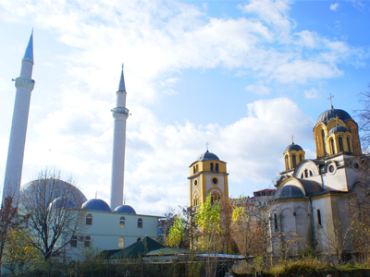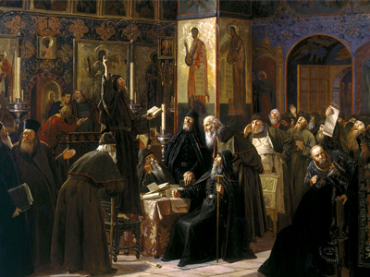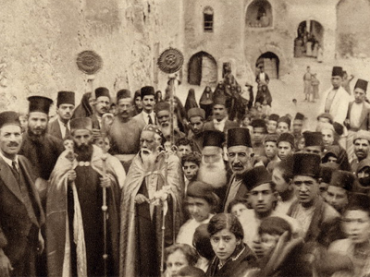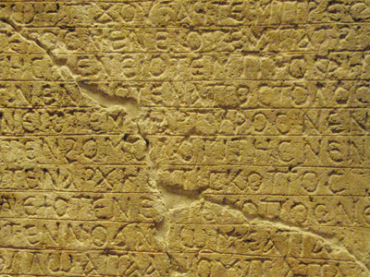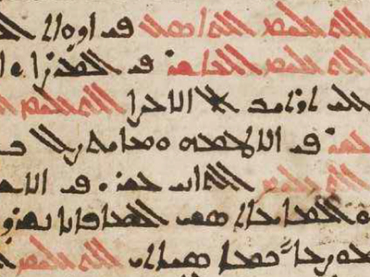Syriac and Eastern Christianity
My Baby Brother Lucian
ISBN: 978-1-61719-081-0
My Baby Brother Lucian is a biography of a baby that is born into a Syriac family as told by his 9-year-old sister. It provides a glimpse of the exciting changes an elder sister faces in the first year of a new baby's life: From what to name the baby, to how the family prepares for a baptism in the Syriac Orthodox tradition, and finally to the one-year birthday party. This book is a simple yet elegant description of the milestones of an infant in his first year of life.
$18.00
Shall this Nation Die?
Series: Syriac Studies Library 69
ISBN: 978-1-61719-041-4
In this volume, Father Joseph Naayem, based on his experiences and conversations with others, narrates the horrors experienced by the Chaldean Christians prior to World War I at the hands of the Turks.
$207.00
Monte Singar
Storia di un popolo ignoto
Edited and Translated by Samuele Giamil
Series: Syriac Studies Library 70
ISBN: 978-1-61719-042-1
This volume contains the Syriac text, with Italian translation, of a catechetical work on the beliefs and practices of the Yezidis based on a manuscript in the Monastery of Rabban Hormizd.
$164.00
Epistulae Novi Testamenti Coptice
Edited by Paul de Lagarde
Series: Kiraz Theological Archive 50
ISBN: 978-1-61719-048-3
Distinguished biblical scholar Paul de Lagarde provides an annotated Coptic version of the New Testament arranged by the General Epistles, preceding Pauline Epistles, and concluding with Philemon. Titles and references are in Latin.
$154.00
Mémoire sur les Migrations des Tsiganes à travers l’Asie
Series: Analecta Gorgiana 527
ISBN: 978-1-61719-080-3
History of the Gypsies in Asia and the Middle East
$53.00
A Quest for Belonging
Anatolia Beyond Empire and Nation (19th-21st Centuries)
ISBN: 978-1-61719-103-9
A Quest for Belonging collects Hans-Lukas Kieser’s works on identities and nationalities in late-Ottoman Anatolia and how their destruction during the First World War continues to resonate today.
$206.00
Population History of the Middle East and the Balkans
ISBN: 978-1-61719-105-3
Population History of the Middle East and the Balkans collects together the work of Justin McCarthy on Ottoman demographics in the nineteenth and twentieth centuries.
$163.00
Lettres de Josué, fils de David, surnommé Bar-Kilo, de Sévère Jacques de Bartelli, surnommé Bar-Chac
Edited with an Introduction by Isaac Armalet
Series: Syriac Studies Library 71
ISBN: 978-1-61719-161-9
This volume contains epistolary selections, in vocalized Serto script, of Joshua bar David (also known as bar Kilo), three questions from Jacob bar Shakko’s Dialogue, and letters from David de Beth Rabban.
$165.00
Ephraem Syrus on the Repentance of Nineveh
A Metrical Homily on the Mission of Jonah
Translation and Introduction by Henry Burgess
Series: Syriac Studies Library 72
ISBN: 978-1-61719-162-6
This volume contains English translations of five works of various lengths from St. Ephrem on the theme of repentance. The translator also includes a lengthy introduction, notes to the translation, and indices.
$183.00
Moses bar Kepha und sein Buch von der Seele
Translated and Annotated by Oskar Braun
Series: Syriac Studies Library 73
ISBN: 978-1-61719-163-3
This volume contains a German translation of a fascinating work on the soul in all its characteristics and aspects from the Syrian Orthodox author Mushe bar Kipho (d. 903).
$164.00
Mastery in Inflecting the Language of the Syrians
By Yusuf Daryan
Series: Syriac Studies Library 74
ISBN: 978-1-61719-164-0
Maronite bishop Yusuf Daryan’s (d. 1920) detailed and lengthy work covers Syriac orthography and morphology, discussed with numerous vocalized examples, which are also generally translated into Arabic.
$220.00
Papal Authority in the Syrian Church
Series: Syriac Studies Library 76
ISBN: 978-1-61719-166-4
In this work, Syrian Catholic priest Isaac Armalet (d. 1954) investigates the subject of papal authority biblically and historically with respect to the Syrian Catholic Church.
$134.00
Syriac Grammar and Poetry
Series: Syriac Studies Library 77
ISBN: 978-1-61719-167-1
This detailed grammar of Syriac by the Maronite George Al-Ruzzi (Risius), written in Arabic, covers poetic meters in addition to the customary grammatical subjects.
$208.00
Thomas of Edessa on the Nativity of the Lord
Edited and Translated by Simon Joseph Carr
Series: Syriac Studies Library 79
ISBN: 978-1-61719-169-5
This volume contains the Syriac text of sixth-century Church of the East author Thomas of Edessa’s On the Nativity, along with a Latin translation and a brief introduction in English.
$153.00
Homonyme Wurzeln im Syrischen
Ein Beitrag zur semitischen Lexicographie
Series: Syriac Studies Library 80
ISBN: 978-1-61719-170-1
Semitist Friedrich Schulthess (d. 1922) here presents a study of forty-nine homonyms in Syriac considered in light of comparative Semitics. Language indices conclude the study.
$118.00
Poems of Gregory Barhebraeus
Edited with an Introduction by Augustinus Scebabi
Series: Syriac Studies Library 81
ISBN: 978-1-61719-171-8
Scebabi here presents in vocalized Serto script a number of poems penned by the famous and prolific Barhebraeus (1225-1286) together with a Syriac-Arabic-Latin glossary of difficult words found in the poems.
$152.00
Severi Philalethes
Edited and Translated by A. Sanda
Series: Syriac Studies Library 82
ISBN: 978-1-61719-172-5
The Philalethes of Severus of Antioch (d. 538) is one of the most important documents of anti-Chalcedonian christological writing. This volume contains the Syriac text, a Latin translation, and a brief introduction.
$182.00
Opuscula Monophysitica Ioannis Philoponi
Edited and Translated by A. Sanda
Series: Syriac Studies Library 83
ISBN: 978-1-61719-173-2
The Philalethes of Severus of Antioch (d. 538) is one of the most important documents of anti-Chalcedonian christological writing. This volume contains the Syriac text, a Latin translation, and a brief introduction.
$192.00
Severi Antiiulianistica
Edited and Translated by A. Sanda
Series: Syriac Studies Library 84
ISBN: 978-1-61719-174-9
This volume contains the Syriac version, with Latin translation, of Severus’ polemical work against Julian, bishop of Halicarnassus, especially on the question of the corruptibility of Jesus’ body.
$222.00
Der Strophenbau in den Gedichten Ephraems des Syrers
Mit einem Anhange über den Zusammenhang zwischen syrischer und byzantinischer Hymnenform
Series: Syriac Studies Library 85
ISBN: 978-1-61719-175-6
This volume studies the strophic patterns used by Ephrem the Syrian, which the author divides into five types. An appendix deals with possible relationships between Byzantine (esp. Romanos) and Syriac poetic forms.
$150.00
Le livre des lois des pays
Texts syriaque et traduction française avec une introduction et de nombreuses notes
Edited and Translated by F. Nau
Series: Syriac Studies Library 86
ISBN: 978-1-61719-176-3
The text published here is the Book of the Laws of Countries, a dialogue in which Bardaisan plays the major role. Nau gives this fascinating text in Syriac (Estrangela) and a French translation along with explanatory notes.
$149.00
Die neu-aramaeischen Dialekte von Urmia bis Mosul
Texte und Übersetzung
Edited and Translated by Albert Socin
Series: Syriac Studies Library 87
ISBN: 978-1-61719-177-0
This volume contains Neo-Aramaic texts, with German translation, from various regions between Urmia and Mosul, a collection of 27 narratives (including proverbs and songs) that offer a wealth of cultural information.
$177.00
The Influence of the Septuagint upon the Peshitta Psalter
Series: Syriac Studies Library 88
ISBN: 978-1-61719-178-7
This volume, the author’s dissertation written under Gottheil’s supervision, investigates the numerous variants between the Syriac version of the Psalms and the Hebrew text in light of those texts themselves and with thorough reference to the Septuagint.
$164.00
Christianity in Travancore
Series: Syriac Studies Library 89
ISBN: 978-1-61719-179-4
This volume covers the history of Christianity in southern India, and is written as a straightforward essay, along with detailed notes at the end of the work.
$120.00
Les origines de l’église d’Édesse et la légende d’Abgar
Étude critique suivie de deux textes orientaux inédits
Series: Syriac Studies Library 90
ISBN: 978-1-61719-180-0
This volume is a study of the origins of Christianity in Edessa, covering the question from both a historical and a legendary perspective, including the Doctrine of Addai.
$134.00
Filter by
Filter by price
Filter by manufacturer

